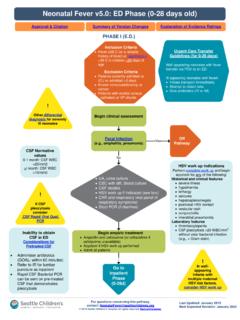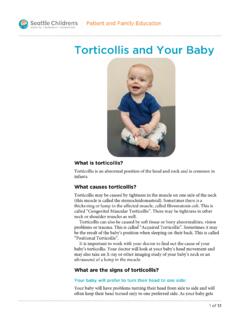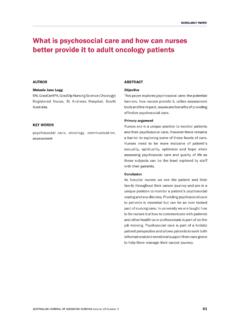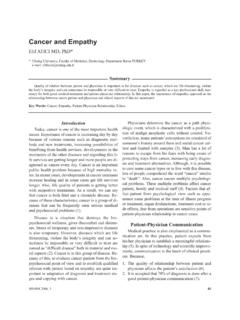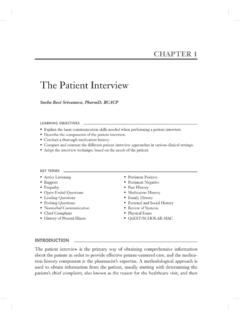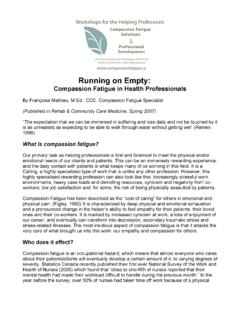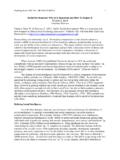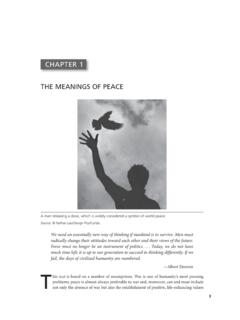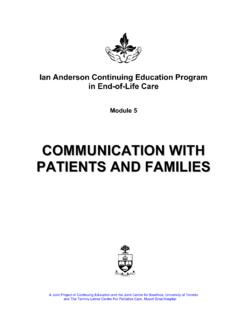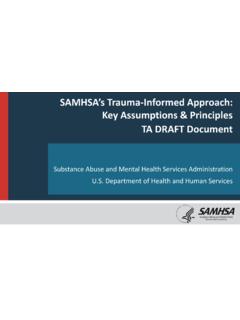Transcription of Excerpted from Reaching Teens, 2nd Edition
1 Excerpted from Reaching Teens, 2nd Edition Strength-Based, Trauma-Sensitive, Resilience-Building Communication Strategies Rooted in Positive Youth DevelopmentChapter 42. the traumatiC impaCt of raCism and disCrimination on Young people and how to talk about it307 Chapter 42 The Traumatic Impact of Racism and Discrimination on Young People and How to Talk About ItMaria Veronica Svetaz, MD, MPH, FSAHM, FAAFP Tamera Coyne-Beasley, MD, MPH, FAAP, FSAHM Maria Trent, MD, MPH, FAAP, FSAHM Roy Wade Jr, MD, PhD, MPH, MSHP Michael Howard Ryan, MS, LPC Michele Kelley, ScD, MSW, MA Veenod Chulani, MD, MS Ed, FAAP, FSAHM Why This MattersThis chapter describes the pervasive negative effects of racism on youth development, as well as on their health and well-being.
2 And the toll it exacts on families and communities who have been racially marginalized. Approaching the topic of racism may not be easy. It can generate empathy , concern, and compassion as much as it can stir defensiveness, anger, hostility, and a wide host of reactions that lie along this continuum. We each approach racism differently according to our lived experiences, self-awareness and critical consciousness, and position in our stratified society. Approaching racism requires us to bring our most compassionate and mindful selves, to suspend emotional reactivity so that we can remain open to viewing the world from the perspectives of others, and to remember that we belong to each other.
3 This chapter, especially crucial in these times of heightened social division, invites all of us to put ourselves into other s shoes, regardless of who we are, our individual origins, or where we come from. In so doing, we may come to recognize our habits of harm, find our pillars of strength, discover the ways to heal, and come to a deeper understanding of what it means to care for one another. Because we belong to each other. IntroductionSadly, trauma is a universal experience that occurs in every community, in all economic strata, and within every demographic group. It does not is a trauma itself, one that hurts Our early recognition of trauma and adverse childhood experiences (ACEs)2 centered on exposure to traumatic experiences and adversity primarily within the home, such as various forms of abuse and neglect and exposure to household stressors.
4 Emerging science has established, however, that Expanded ACEs stressful childhood exposures occurring outside the home, which include experiences of discrimination exert similar negative effects on physical, emotional, webelong to each other. together, regardless of race and beyond race, we must want what is right for each other, aspire for better, and work for greater if we are to leave the generations of youth that will come after us a just and equitable 3074/17/20 11:28 AMSECTION 6. WORKING WITH ADOLESCENTS WHO HAVE ENDURED TRAUMA AND MARGINALIZATION308and social health throughout the life In fact, they can have an impact even before an individual is conceived.
5 Epigenetics has helped us understand that one s DNA may be altered depending on the stress of the parent s and youth experience distinctly different realities because of the color of their skin. Beyond race, we are multidimensional beings whose lives reflect the intersections of our many social identities: age, gender, sexual orientation, social class, and religion, among others. The cumulative impact of discrimination, including racism, sexism, misogyny, homophobia, and religious discrimina-tion, has significant implications for communities and is especially amplified among individuals and groups who have historically experienced A model that integrates discrimination into an overarching framework that describes the pathways through which adversity affects humanity is presented in Box has long been a part of human history.
6 At its extremes, this has included genocide, slavery, and the colonization of indigenous people. While we readily recognize and widely condemn overt acts of racially motivated hate today, racism continues to permeate our society. It is not only seen through personally mediated acts but also embedded into our institutions, disguised in our daily interactions, and etched into our Racism is trauma that affects all our youth, especially youth of color who have historically experienced Considering the tide of nationalism, ethnocentrism, xenopho-bia, and overt expressions of racism of recent times, addressing racism is a critically urgent need for those of us who care for and about this chapter, we call on all, regardless of race and beyond race, to want for other, to aspire for better, and to cultivate what Ruth King defines as a culture of care.
7 In which everyone is in a relation-ship with humanity with a wise heart. This includes having moral character wrapped in compassion, compassion to ourselves. 8 Key Concepts to Highlight About Teen Development and Racism in Current Childhood experiences are broader than initiallymeasuredSignificant childhood adversity is associated with suboptimal outcomes across the life course. The sentinel ACE (Adverse Childhood Experiences) Study, published in 1998, demonstrated a graded relationship between childhood exposure to various forms of abuse, neglect, and household stressors and risk for adult health problems, including mental health conditions (substance use, depression, anxiety, and post-traumatic stress disorder) and physical health conditions (ie, cardiovascular disease, autoimmune disorders, cancer, emphysema, diabetes, fractures).
8 In a replication of the ACE Study among adults in Philadelphia, research-ers found that expanded ACEs (stressful childhood exposures occurring outside the home, such as com-munity violence, living in unsafe neighborhoods, and racial discrimination) were more commonly endorsed by respondents than the original Also, expanded ACEs were strongly associated with poor adult health Given that 14% of study respondents endorsed exposure to the expanded ACEs and not the original ACEs, focusing only on the original narrowly defined adverse experiences within the household may result in missed opportunities to prevent and intervene with youth and families exposed to toxic (See Chapter 36, The Impact of Trauma on Development and Well-being, for more on toxic stress.)
9 Undermines development and well-being: racismis an expanded aCe and a social determinant of healthChildren and adolescents are especially vulnerable to discrimination because their developmental growth depends on social interaction and ,11 One of the many tasks of adolescence is to establish critical aspects of Identities are not formed in a vacuum but, rather, are shaped from the different spheres, influences, and exposures that surround youth as they develop. These forces can either create tension and deliver toxic levels of stress or build resilience and other 3084/17/20 11:28 AMChapter 42. the traumatiC impaCt of raCism and disCrimination on Young people and how to talk about it309 Box Trauma Has No Color, and Discrimination Is Another Trauma to BearEmbedded within the framework are the following assumptions:1.
10 Suffering is tragically a theme of the human condition. It has no demographic nor When children and adolescents suffer from exposure to trauma or from a lack of the nurturant protective force of connected adults, it may affect their bodies, brains, and In low-resource contexts, adult stress is magnified, and they must focus on basic survival issues. This may increase the prevalence of trauma-inducing circumstances and may interfere with adults having internal resources and time to fill their vital role in creating nurturant, secure relationships with their children. Therefore, we must have an intergenerational focus to get to the root of the determinants have a pervasive effect on the development, health, and well-being of young lives.



